
Instruction Manual
UPPER ARM
BLOOD PRESSURE MONITOR
Model BPM610
This manual and product are not meant to be a substitute for advice provided by
your doctor or other medical professional. You are not to use the information
contained herein, or this product for diagnosing or treating a health problem or
prescribing any medication. If you have or suspect that you have a medical
problem, promptly consult your healthcare provider.
The device is designed for non-invasive measurements and monitoring of adults’
arterial blood pressure. It measures human's systolic blood pressure, diastolic blood
pressure and heart rate on the arm by oscillometric measurement method.
The device is recommended for use by people over the age of 18 and is for home
use and not clinical use.
Blood Pressure Monitor Intended Use
*Attention!
To operate the device properly and get the best result from it, please read the
Instruction Manual thoroughly before you begin measuring and keep it carefully
so that you can access and consult it at any time.
Medical Disclaimer
1-1. What is blood pressure ?
1. About Blood Pressure
Having one's blood pressure measured by a doctor in a hospital or a clinic, and a
group health checks, tends to stimulate nervousness in the subject and may even
create high blood pressure, blood pressure also varies in accordance with a variety of
conditions and so judgment is not possible on the basis of a single measurement.
The blood pressure measured first thing in the morning after getting up, before taking
any food and with the subject still, is known as the fundamental blood pressure. In
practice it is rather difficult to record the fundamental blood pressure, but to come as
near as possible to measuring the blood pressure in an environment that is close to
this is why it is useful to take the measurement at home.
Blood pressure is a measurement of the force of blood flowing against the walls of
the arteries. Arterial blood pressure is constantly changing during the course of the
cardiac cycle. The highest pressure in the cycle is called the systolic blood pressure
and the lowest is the diastolic blood pressure. Both of pressure readings, the systolic
and the diastolic, are necessary to enable a physician to evaluate the status of a
patient's blood pressure. Many factors such as physical activity, anxiety or the time of
day can influence your blood pressure. Blood pressure is typically low in the morning
and increases from the afternoon to the evening. It is lower in the summer and higher
in the winter.
1-2. Why is it useful to measure blood pressure at home?
A. WHO blood pressure classifications
Standards for assessment of high or low
blood pressure without regard to age, have
been established by the World Health
Organization (WHO), as shown in the chart.
Optimal
Normal
High normal
Mild hypertension
Moderate hypertension
Severe hypertension
120 130
85
80
95
100
90
105
110
140 150 160 170 180
* Figure No.1
B. Variations in blood pressure
* Figure No.2
Individual blood pressures vary greatly
both on a daily and a seasonal basis.
These variations are even more pronounced in hypertense patients.
(Hypertense: means a person who has high blood pressure symptom.)
Normally the blood pressure rises while at work
and is at its lowest during sleeping period. The
graph below illustrated the variations in blood
pressure over a whole day with measurement
taken every five minutes. (The thick line
represents sleep. The rise in blood pressure at 4
PM <A in the graph> and 12 PM <B in the
graph> correspond to an attack of pain.)
● Please rest for at least 5 ~ 10 minutes before taking the measurement.
● To allow your blood vessels to return to the condition prior to taking the measurement,
please wait at least 3 ~ 5 minutes between measurements. You may need to adjust the
wait time according to your personal physiological situation.
● If you have one of the circulatory problems as arteriosclerosis, diabetes, liver disease,
kidney disease, severe hypertension, peripheral circulation......, please consult your doctor
or healthcare professional before using the devices.
● Blood pressure measurements should be interpreted by a physician or trained health
professional who is familiar with one's medical history. By using the unit regularly and
recording the results for the physician to interpret, one can keep physician informed of the
continuing trends in one's blood pressure.
● Wrap the cuff snugly around your arm, the cuff must be at the same level as your heart.
● Do not move the unit during measurement, or accurate measurement can not be achieved.
● Take measurement in a relaxed position without talking.
● Do not wrap the cuff over jacket / sweater sleeve, or measurement cannot be done.
● Keep in mind that blood pressure naturally varies from time to time throughout the day and
is affected by lots of different factors such as smoking, alcohol consumption, medication,
and physical activities.
2. Important information before use of the unit
● Blood pressure measurements taken with the unit are equivalent to those obtained by a
trained observer using the cuff / stethoscope auscultation method and are within the accuracy
limits prescribed by the American National Standard for Electronic or Automated
Sphygmomanometers.
● Wait 30 ~ 45 minutes before measurement if you have just consumed caffeinated beverages
or smoked cigarettes.
4-2. Irregular Heartbeat Detector (IHB)
*NoteΜ
● Any irregular heartbeat detected will not be stored in the memory.
The appearance of this symbol, , signifies that a certain pulse irregularity was detected
during the measurement. Talking, moving, shaking or an irregular pulse during the
measurement can result in the appearance of this icon. Usually this is not a cause for
concern, however if the symbol appears often, we recommend you seek medical advice.
Please note that the device will not replace a true cardiac examination, but serves to detect
pulse irregularities at an early stage. As a safeguard, we recommend that if you have
arrhythmias such as atrial or ventricular premature beats and atrial fibrillation or any other
special conditions you should check with your physician before using your BPM.
The hearbeat rhythm that is more than or less than 25% from the average heart beat
intervals is usually defined as an irregular heartbeat rhythm. In order to filter the unstable
status of user and avoid affecting the detection of heart rate from any movement, shaking or
talking in the begining of measurement, the method of averaging heart beat intervals of
subject device is calculated with the three proper heart beat pulses detected in the begining
of measurement and that is different from a strict mathematical averaging of all recorded
intervals. At least 3 beats with at least 25% difference from the average heart beat interval will
generate the IHB symbol on the LCD.
*Note!
When a person’s systolic and diastolic pressures fall into different
categories, the higher category should apply.
e.g. systolic pressure 181 & diastolic pressure 99 the result should
be in Red category (Severe hypertension)
systolic pressure 110 & diastolic pressure 95 Yellow category
(Mild hypertension)
When the low battery symbol appears
on the display, please change the batteries.
Replace all the batteries with new ones and do
not mix new and old batteries. Do not mix
alkaline, standard (carbon-zinc) or rechargeable
(cadmium) batteries either. It may shorten the
battery life or cause the device to malfunction.
5. Inserting/ Changing Batteries
*Attention!
● Batteries are hazardous waste. Do not dispose them together with the household
garbage. Please take the used batteries to the recycling collection point according to
your local regulations.
● Keep the battery away from small children.
● To prolong the battery life and prevent damage caused by leakage, remove the
batteries from the device if the device is not to be used for a long period.
● Memories (if any) will not be deleted during battery replacement.
● After replacing the batteries, reset the year, date and time.
Optimal
Red
Orange
Yellow
Green
Normal
High normal
Mild hypertension
Moderate hypertension
Severe hypertension
120 130
85
80
95
100
90
105
110
140 150 160 170 180
WHO
* Figure No.3
3-1. Name of the parts
3. Device Description
3-2. Description of display symbols
* Figure No.4
4. Main feature:
4-1. WHO Indicator
This device is equipped with WHO Blood Pressure Indicator which classifies your
blood pressure measurements into six stages (Optimal to Severe hypertension)
based on WHO classication on blood pressure levels as shown in below chart:
After each measurement is completed, the LCD display will show your position
automatically on the six segments of the bar indicator which corresponds to WHO
Blood Pressure Indicator.
*Source: WHO, 1999
Stages of blood pressure levels Systolic (in mmHg) Diastolic (in mmHg)
Grade 3
Grade 2
Grade 1
Severe hypertension
Moderate hypertension
Mild hypertension
≥180
160~179
140~159
130~139
120~129
<120
High-normal
Normal
Optimal
≥110
100~109
90~99
85~89
80~84
<80
HOUR: MINUTE
SYSTOLIC PRESSURE
MEASUREMENT AVERAGE
BLOOD PRESSURE UNIT
DIASTOLIC PRESSURE
HEART RATE
WHO PRESSURE
INDICATOR
MONTH/ DATE
LOW BATTERY
MEMORY NUMBER
IRREGULAR HEARTBEAT
SYMBOL
6. Attaching arm cuff
6-1. Press your brachial artery by two fingers approximately 1 inch
above the elbow on the inside of your left arm.
6-2. Determine where your strongest pulse is. Slide the end of arm
cuff furthest from the tube through the metal ring to a loop.
The smooth cloth should be on the inside of the cuff.
6-3. If the cuff is located correctly, the Velcro will be on the outside
of the cuff and metal ring will not touch your skin.
6-4. Put left arm through the cuff loop. The bottom of the cuff should
be approx. 0.5 inch above elbow. The cuff should lie over the
brachial artery on the inside of the arm.
6-5. Pull the cuff so that the top and bottom edges are tightened
around your arm.
6-6. When the cuff is positioned properly, press the Velcro firmly
against the pile side of the cuff.
6-7. Sit on a chair and place your arm on the table so that the cuff is
at the same level as your heart.
6-8. Relax your arm and turn your arm upward.
6-9. Make sure there are no kinks in the air tube.
Remove the battery cover at the back of the unit and insert 4 pieces AAA alkaline
batteries into battery compartment.
Make sure the polarities "+" and "–" ends are properly positioned.
7-1. Insert batteries in position:
7. How to Measure
A. Open battery cover.
B. Refer to the picture in positioning batteries.
C. All segments will appear on the display in 3 seconds.
7-2. Setting Date and Time:
A. Press " " button ("year" starts flashing). Press " + " button to set the current year.
B. Press " " button ("month" starts flashing). Press " + " button to set the current
month.
C. Press " " button ("date" starts flashing). Press " + " button to set current date.
D. Press " " button ("hour" starts flashing). Press " + " button to set current hour.
E. Press " " button ("minute" starts flashing). Press " + " button to set current
minute.
F. Press " " button to save the settings.
7-3. Steps to take blood pressure measurement:
A. Press + button to select a particular memory zone (1,2, or 3).
B. Press "START/STOP" button to start measurement.
The monitor will automatically inflate to the level
that is right for you.
*Note!
When taking repeat measurements, make sure to select the same memory
zone so that the measurements are recorded in the appropriate memory.
C. After inflation of the cuff, the pressure will slowly decrease and when a pulse is
detected, the HEART RATE SYMBOL will start flashing.
*Note!
If the cuff does not stop inflating, remove the cuff at once.
c. Press
"
MEM.
"
button. The latest measurement data will appear with the number as well as
the recording date and time. Data are recalled from the latest measurement to the oldest.
d. Press
"
MEM.
"
button to read the next measurement data.
e. To stop reading stored data, press
"
START/STOP
"
button.
D. When the measurement is finished, the systolic pressure, diastolic pressure, heart rate
and WHO INDICATOR SYMBOL will be displayed for 1 minute.
E. The monitor will automatically shut off after 1 minute if without any operation.
7-4. Storing, recalling and erasing measurement data:
A. Storing data:
After each measurement, the systolic and diastolic pressure, heart rate with the time
and date will be automatically stored. The monitor features a 3 zone memory capability.
Each memory zone holds the last 40 measurements, replacing the oldest data with new
one.
B. Recalling data:
a. Press
" + "
button to select memory zone.
b. Press
"
MEM.
"
button to enter Memory Mode. The average of last 3 measurement
data will first appear on the display.
C. Erasing data:
a. Press " + " button to select the memory zone (1, 2 or 3), then press
"MEM" button.
b. Press and hold " + " and " " buttons simultaneously, all stored data ,
including the average reading, in the selected memory zone will be
erased.
c. To confirm the data has been erased, press
"
MEM.
"
button, no data (except month,
date, time and memory zone number) should appear.
*Note!
● If there is no data in the selected memory zone, nothing (except month, date, time and
memory zone) will appear on the display.
● If there is 1 data in the selected memory zone , the measurement data will appear on
the display.
● If there are 2 data in the selected memory zone, the average of the 2 data will appear
on the display.
8. Maintenance
8-1. Clean the device body, case and the cuff carefully with a clean, soft and slightly dampened
cloth and then wipe them dry with another piece of dry cloth.
8-2. Do not use thinner, alcohol, petrol (gasoline) or any strong cleansers to clean.
8-3. Do not wash the cuff or make it wet, and never use chemical cleaner on it.
8-4. Do not in any way twist the cuff.
8-5. Make sure no water will enter the main unit.
8-6. When the unit is not to be used for a long time, remove the batteries. (Leaking of battery liquid
can cause damage.)
8-7. Do not attempt to disassemble or change any parts of the monitor, including cuff.
8-8. If any suggestion or service is requested please consult your service station.
8-9. Do not place the item directly under the sunlight, in high temperature, or humid and dusty
places.
8-10. Do not store in extremely low (less than – 20 °C) or high (more than 70 °C) temperature.
8-11. To avoid accidental strangulation, keep this product away from children and do not drape
tube around neck.
Display mark Corrective action
Battery symbol
Measurements in progress.
Do not move or talk.
Replace all four batteries with new ones.
Insert the batteries in correct polarities.
Pulse
symbol
Flashes on the LCD when pulse is
detected during measurement.
Condition/Cause
Appears when the battery voltage is
excessively low.
IHB symbol
Repeat the measurement.
Relax for at least 5 minutes and sit comfortably
and quietly before you restart a measurement.
Appears for 1 minute when the user was
talking, moving or shaking or an irregular
heart beat was detected during measurement.
9. Display Messages/Troubleshooting
Model Number
Method of Measurement
Range of measurement
Accuracy
Inflation
Exhaust
Display
Dimension
Unit Weight
Sets of memory
Cuff size
Operating Temperature
Storage Temperature
Power Supply
Battery Life
Auto Power Off
Accessories
BPM610
Oscillometric
Pressure 0 ~ 300 mmHg
Pulse 40 ~ 199 beats/minute
Pressure +/- 3 mmHg
Pulse +/- 5% Max
Automatic inflation (Air Pump)
Automatic exhaust valve
Liquid Crystal Display
10.5 x 13.5 x 5.0 cm (L x W x H)
Approx. 250 g with batteries
3 databases of 40 memories each = total 120 sets
Arm circumference approx. 23 ~ 33 cm/ 9 ~ 13 inch
+10 °C to + 40 °C, less than 85% R.H.
- 20 °C to + 70 °C, less than 85% R.H.
"AAA" (1.5 V) Alkaline battery x 4
About 6 months when used once a day
Whenever not used for 1 minute
4 pcs "AAA" (1.5 V) battery, arm cuff with tube,
instruction manual, pouch.
These specifications are subject to change without notice for purpose of improvement.
10. Specifications
0197
This blood pressure monitor complies with the EC Directive and bears the CE
mark “CE0197”. This blood pressure monitor also complies with mainly
following standards,(included but not limited)
Safety standard:
EN 60601-1 Medical electrical equipment part 1: General requirements for safety
EMC standard:
EN 60601-1-2 Medical electrical equipment part 1-2: General requirements for safety- Collateral
standard: Electromagnetic compatibility- Requirements and tests
Performance standards:
EN 1060-1 Non-invasive sphygmomanometers - General requirements
EN 1060-3 Non-invasive sphygmomanometers - Supplementary requirements for
electromechanical blood pressure measuring systems.
EN 1060-4 Non-invasive sphygmomanometers - Test procedures to determine the overall
system accuracy of automated non-invasive sphygmomanometers.
Important /Note! Read the operating
instructions.
Consult instructions thoroughly before
use.
Classification:
- Internally powered equipment
- BF type applied part
- IPX0
- Not suitable for use in presence of
flammable anaesthetic mixture with
air or with Oxygen or nitrous oxide
- Continuous operation with short-time
loading
To avoid inaccurate results caused by
electromagnetic interference between
electrical and electronic equipments, do
not use the device near a cell phone or
microwave oven.
Discard the used product to the recycling
collection point according to local
regulations.
Authorized Representative in the
European Community
EMERGO EUROPE
Molenstraat 15, 2513 BH,
The Hague, The Netherlands
TEL : +31-70-3458570
FAX : +31-70-3467299
Manufacturer:
HEALTH & LIFE Co., Ltd.
9F, No. 186, Jian Yi Road,
Chung Ho City 235, Taipei, Taiwan
Distributor:
Sabre Nederland b.v.
Ellermanstraat 23
1099 BX Amsterdam the Netherlands
Note
1. LCD DISPLAY
2. AIR PLUG
3. ARM CUFF
4. AIR JACK
5. CUFF TUBE
6. START/STOP BUTTON
7. RECALL MEMORY BUTTON
8. MODE BUTTON
9. SET BUTTON
10. UM-4(AAA)1.5 V x 4
ALKALINE BATTERIES
*Caution!
Substitution of a component
different from that supplied
might result in measurement
error.
10
7
9
8
* Figure No.5
Elbow
Pile Side
Material
Smooth
Velcro
Metal ring
Bottom Edge
1/2 Inch(1.5cm)
Cuff Tube
Cuff Tab
Indicates the average of last 3
measurements.
Indicates the measurement number.
Measurement Error:
Air Circuit Abnormality:
Error Determining Measurement Data:
Pressure Exceeding 300 mmHg:
Measure again. Wrap the cuff correctly and keep arm
steady during measurement.
Check cuff connection. Measure again.
Measure again.
Turn the unit off to clear, then measure again.
Measurement
avgerage symbol
Measurement
number
symbol
Measuring
error symbol
Measuring
error symbol
Measuring
error symbol
Measuring
error symbol
1.5 V UM-4
AAA (LR03/ R03)
● To ensure precise measurement reading,
recalibration of the device is recommended
after 2 years from the date of purchase.
Shipping plus handling cost and recalibration
service fee shall be charged accordingly.
P/N: 323101289 VER:001


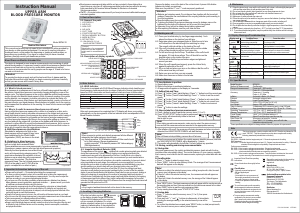

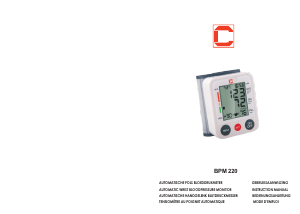
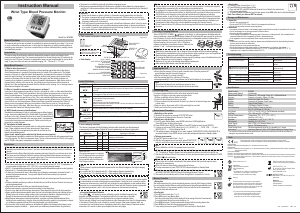

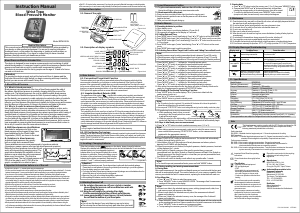
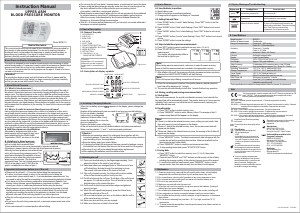
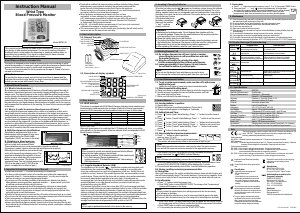
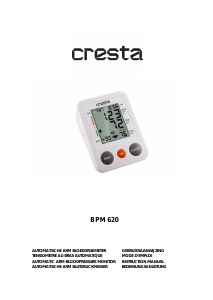

Join the conversation about this product
Here you can share what you think about the Cresta BPM610 Blood Pressure Monitor. If you have a question, first carefully read the manual. Requesting a manual can be done by using our contact form.